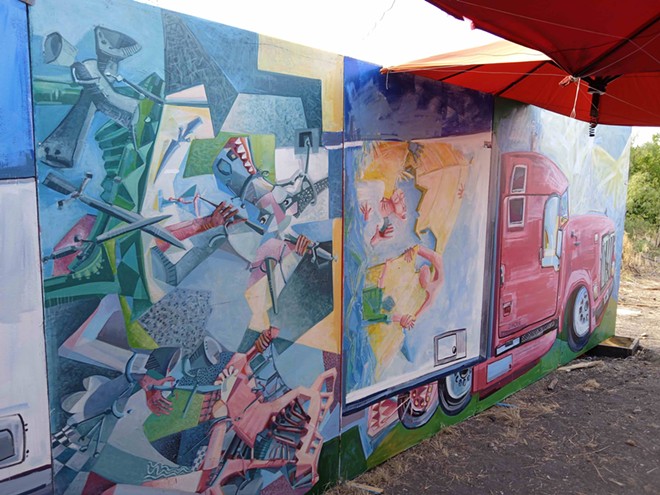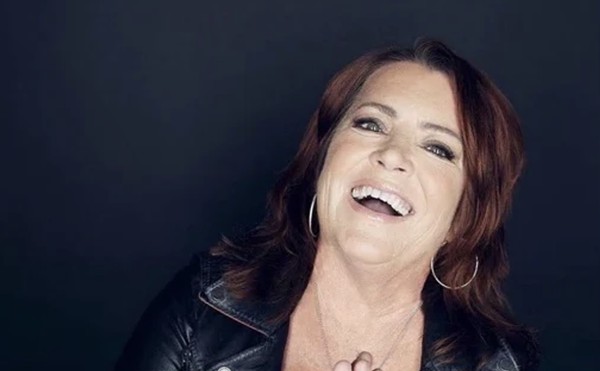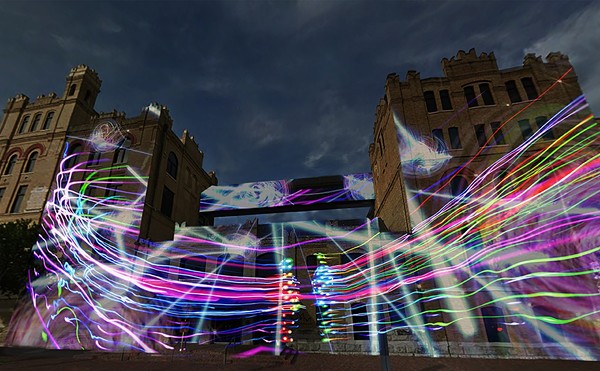
Six weeks after 53 migrants died in the back of a sweltering tractor trailer abandoned in Southwest San Antonio, a memorial continues to grow at the site. That desolate stretch of Quintana Road has become sacred ground for people trying to make sense of the tragedy.
The work of artist Roberto Marquez stands at the center of this place of mourning and contemplation. His Picasso-inspired mural of a red tractor trailer carrying dozens of migrants is splashed across four large panels — a depiction of what played out there on June 27.
Artists often speak about their work being "for the people," even as it hangs on gallery walls curated by gatekeepers. However, Dallas-based Marquez doesn't just paint his subjects. He also lives among them and immerses himself in their struggles.
A migrant from Mexico now in his 60s, Marquez has been painting for decades. But it wasn't until 2018 that his art turned into activism.
Since that awakening, he's created murals at the site of the Surfside condominium collapse in Florida, across the street from Robb Elementary School in Uvalde, under a destroyed bridge crossing Ukraine's Irpin River and under the Del Río-Ciudad Acuña International Bridge, where nearly 15,000 Haitian migrants converged in 2021.
"I wish I had started doing what I do 20 years back," Marquez said. "I started real late."
Marquez's immersion in activism happened when he traveled to Tijuana four years ago to volunteer when thousands of Central American asylum seekers took shelter at the Benito Juarez Sports Complex. He only planned to stay a few weeks but remained for months.
"At first, I wasn't thinking about activism," he said. "But eventually, you have to respond to the injustices. Now, it's just a way of life."
From Ukraine to South Texas
Marquez's trip to Ukraine earlier this year involved more than creating art. His volunteer work included passing out food and picking up dead bodies in war-torn communities.
"I don't go with the idea of painting," Marquez said. "First I go and ask what is it that I can do to help."
After his time in Ukraine, Marquez returned home to Texas to see his family and rest. Little did he know, he'd soon be packing his bags again — this time for Uvalde, where the Robb Elementary shooting claimed the lives of 19 children and two teachers.
Days later, the deaths of the migrants in an abandoned tractor-trailer drew Marquez to San Antonio. He spent nearly two weeks working in the heat, painting what he refers to as the "Trailer of Death."
To distinguish himself from the esteemed Mexican painter of the same name, Marquez uses the moniker "Robenz." But with one view of Marquez's work, it is evident the two artists are on very different paths.
In the mural, Marquez depicts the many obstacles migrants face on their journeys to the United States — hunger, confrontations with authorities and crossing the Rio Grande River. He makes the point that migrants come from all over the world, sometimes devoting years to the journey.
"I'm portraying the way many migrants go through the water like the sea or the Rio Bravo," Marquez said of the mural. "I didn't just want to portray a tragedy, but I also wanted to bring hope. That's why I have an angel in the back that's going to rescue the ones that are alive."
Other memorials
During his time working on his San Antonio project, Marquez took note of the others who created their own memorials. The crosses along the roadside are adorned with flowers, and each bears the name of one of the migrants who perished in the back of the trailer.
"Two guys named Jose and David were the ones that built the crosses," Marquez said. "It was a lot of cooperation from different people. They went to Home Depot and bought lumber. It took them about a day and a half to put them all up."
On the day I met Marquez at the site, a group of elderly women recited prayers as mourners gathered to pay their respects, their voices traveling. One of the women handed me a rosary.
The railroad company that owns the land where the memorial is located is willing to work with the community to turn it into a permanent memorial, Marquez said. The site makes it clear that even when governments fail, the true soul of a people — and their culture — continues to flourish.
"Any situation where there is a loss of life, people want to know that someone is there for them," Marquez said. "We want to let them know that we are here and hopefully it doesn't happen again."
Stay on top of San Antonio news and views. Sign up for our Weekly Headlines Newsletter.















